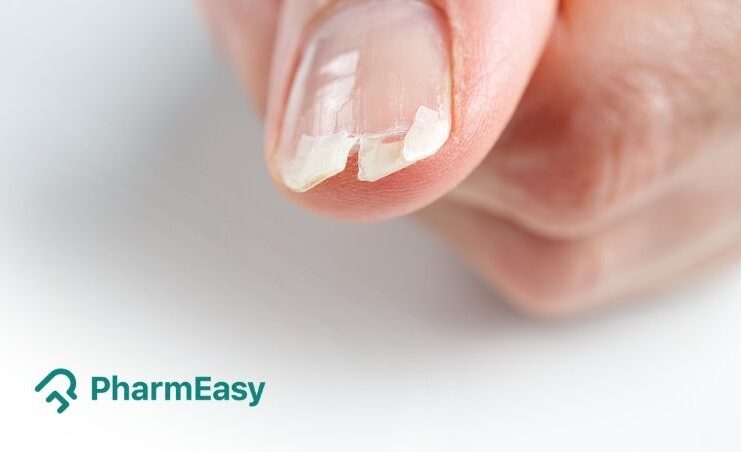Introduction
When we speak about overall health, we cannot ignore our nails. Distressing events like nail splitting can cause alarm. These can be unsightly and could be painful as well1,2. We’ll discuss how to keep our nails strong and good-looking.
We’ll try to understand what is nail structure and why it’s vital. Further, we’ll discuss why nails might split. Lastly, we’ll talk about the complications one could face due to severe nail splits. We will also discuss some frequently asked questions regarding this topic.
What are Nails Made of?
1. Nail anatomy
Our nails consist of a tough, protective protein named keratin. This protein forms our hair and skin’s outer layer too³. Here are some crucial parts of our nail unit.
- Nail matrix: This is beneath the cuticle, producing new nail cells.
- Nail bed: It feeds nail growth and sits under the nail plate.
- Nail plate: This is the visible and hard part of the nail. It consists of keratin-filled dead cells.
- Lunula: This refers to the small white area at the nail base that looks like a crescent moon.
2. Chemical composition of nails
Our nails are mostly made up of keratin protein, which give them their toughness³. They also contain tiny amounts of different minerals. These include zinc, iron, and calcium⁸,⁹. These elements add to the strength and health of our nails.
3. Growth process of nails
Nail growth starts in the matrix. Special cells here make keratin and push older cells towards the nail tip. As these old cells get filled with keratin and are compressed, hard nail plates are formed. These appear on the surface. Fingernails generally grow around 3 millimeters each month. Toenails have a slower growth rate³.
Causes of Split Nails (Onychoschizia)
Nail splitting, or onychoschizia, occurs due to several reasons. The most common factors can be classified into category-based causes. These categories include factors related to moisture, behaviour, injury, infection, and age. They also include underlying medical issues and nutrient deficits.
1. Moisture-Related Causes
Contact with water and moisture-rich areas might significantly affect your nails health and appearances.
- Excess exposure to water: Frequently wetting your hands, like when washing dishes or bathing, can weaken nails. This can cause nail splitting and brittleness. Long exposure to water lets the nail plate absorb moisture. This moisture then evaporates, drying the nails and making them prone to damage⁶.
- Nail polish and nail polish remover: Some nail polishes and nail polish removers have harsh chemicals. These could strip the nail of its natural oils, leading to dryness and splitting eventually. Choose gentle, acetone-free nail varnish removers and hydrating nail varnishes to avoid nail damage⁶.
- Climate-related dryness: Living in a dry place can make nails dehydrated. This could lead to splitting. Using a humidifier at home and applying moisturizers for hands and nails regularly can maintain healthy nail hydration levels12.
2. Behavioural Causes
Split nails could occur due to some habits and grooming practices.
- Picking or biting nails: Biting or picking at nails can stress the nail, causing small cracks. These could then lead to severe splits. Stopping these habits and finding healthier ways to cope may lower the risk of such nail splits⁶.
- Improper nail care and grooming: Mistakes while trimming and filing nails can weaken them. To avoid nail splits, trim your nails with sharp nail clippers. Use a nail file in one direction, rather than sawing back and forth⁶.
- Frequent use of artificial nails: Having fake nails on for a long time can weaken the real nail. This might make them more likely to split. Giving your nails a break from fake enhancements is key to keeping them healthy⁶.
3. Nail Injuries and Trauma
Injuries can cause split nails. They could result from sudden or repeated trauma.
- Acute injuries: Sudden events like stubbing a toe or smashing a finger can cause direct damage to nails. This could result in splitting⁶. Taking care to protect fingers and toes, and avoiding risky actions may avoid sudden nail injuries.
- Repetitive trauma: Minor injuries that occur again and again, like typing or playing musical instruments, can weaken nails over time⁶. Recognizing and reducing these actions is key to avoiding nail splits due to long-term injuries.
- Occupational hazards: Jobs or activities that need a lot of hand or foot contact might raise the risk of nail damage and splitting⁶. Using the right safety gear, like gloves or closed shoes, can lower the risk of job-related nail injuries.
4. Infections and Illnesses
Infections can weaken the nail and raise the risk of splitting.
- Bacterial infections: Bacterial infections, like paronychia, could cause swelling and weakness of the nail. Proper hygiene and prompt management with antibiotics in consultation with a dermatologist are vital4.
- Fungal infections: Onychomycosis, a fungal infection affecting the nails, could cause nail thickening, change of colour, and splitting7. Clean foot habits, avoiding damp areas, and early management with anti-fungal drugs prescribed by a doctor can help reduce such infections.
- Psoriasis and other skin diseases: Nail problems are common in people with psoriasis. This could cause nail changes, such as pitting or crumbling, leading to nail splitting⁵. The right management for the base skin problem may delay nail issues due to psoriasis.
5. Underlying Medical Conditions
Some health conditions affect nail health and make splitting more likely.
- Thyroid disorders: Both underactive (hypo) and overactive (hyper) thyroid can cause changes in nail health like brittleness or splitting¹. Diagnosis and management of these conditions may improve nail health.
- Iron deficiency anaemia: Low iron levels can cause various symptoms like brittle, weak, and splitting nails⁸. If iron deficiency anaemia is suspected, consult a healthcare professional for evaluation and management.
- Autoimmune diseases: Some autoimmune diseases, like lupus, can cause nail issues, including splitting¹. Management of the base autoimmune problem is key in dealing with related nail problems.
6. Nutrient Deficiencies
Shortage of certain vitamins and minerals can lead to bad nail health.
- Vitamin B7 (Biotin) deficiency: Biotin plays a key role in keeping nails healthy. Shortage can cause splitting, brittleness, and weakness¹¹. Getting enough biotin in the diet or through dietary supplements may help strengthen nails.
- Protein deficiency: Nails are mostly made up of protein (keratin). A diet lacking in protein can lead to weak and splitting nails⁶. Make sure you include enough sources of protein in your diet to encourage healthy nail growth.
- Other essential vitamins and minerals: A balanced diet with enough zinc, calcium, and other necessary nutrients may avoid nail splitting⁸,⁹. It also supports overall nail health.
7. Age-Related Causes of Nail Splitting
Age-related changes can cause our nails to split.
- Structural changes in nails: As we age, our nails grow more slowly. They may become more prone to damage and splitting12. These age-related structural changes in the nails might need special care to maintain healthy nails.
- Decreased blood circulation: Growing older can affect blood flow, especially to our hands and feet. Lower blood flow can lead to weak nails and splitting12.
- Skin changes affecting nails: As we get older, our skin loses its elasticity, moisture, and thickness. This could affect the health of our nails, causing them to split12.
Serious Nail Splits and Complications
While many nail splits may be managed at home, some cases might turn severe. These might need medical help.
Signs and symptoms of a severe split
Here are the symptoms you might see if your split nail is very bad.
- Pain: An extensive or deep split nail can cause a lot of pain. This can make doing daily tasks hard and uncomfortable.
- Inflammation: A serious nail split might cause redness or swelling around the nail.
- Infection: If a nail split isn’t treated right, it might get infected. Signs include redness, pain, and swelling that gets worse. You might also see pus form or smell a bad odour⁷.
Complications
Not treating a severe nail split properly or ignoring it can lead to worse problems.
- Chronic paronychia: Not treating a nail split can cause chronic infection of the skin around the nail. This is known as paronychia. It can be painful, look ugly, and be hard to manage⁴.
- Permanent damage to the nail bed: If a serious nail split isn’t looked after right, it could cause permanent harm to the nail bed beneath it. This may change future nail growth and how the nail looks12.
- Nail matrix damage: A severe nail split could also harm the nail matrix, which is responsible for nail growth. This harm could change the look and structure of the nail in a permanent way³.
Management of Split Nails
Caring for nails properly may play a big role in avoiding nail splits. It also helps promote overall nail health.
1. Proper nail care and grooming
Good nail care habits may help keep your nails strong and healthy.
- Trimming technique: Use clean and sharp nail clippers to trim your nails. You should trim them straight across. Then, softly round the tips in a curve. Avoid cutting nails too short as this can weaken the nail and cause splitting⁶.
- Filing techniques: When you file your nails, use a fine-textured nail file. File in one direction, avoiding saw-like motions. This stops rough edges that might lead to splintering⁶.
- Nail strengthener products: Consider using products designed to strengthen nails. They may improve the toughness of nails. This minimizes the risks of them splitting¹⁰.
2. Home remedies for split nails
Besides good nail care, there are some home remedies that may help recover, strengthen, and protect split nails.
- Hydration and moisturizing: Keep your nails well hydrated and moisturized to avoid splintering. Regularly using hand creams and cuticle oils may help keep moisture levels high. This helps promote healthy nail growth.
- Nutrition and diet: A well-balanced diet that is dense in nutrients may help improve nail health. It can also lead to stronger nails that won’t split as easily. Try to consume the right amounts of different vitamins and minerals through a plate full of various color foods daily. Make sure to get biotin, protein, iron, and zinc in your diet¹⁰,¹¹.
- Essential oils: Essential oils such as tea tree or lavender oil might help improve nail health. They may reduce the risk of splitting13. Apply these oils to your nails and the skin around it. This may promote hydration and offer antifungal and antibacterial benefits.
When to See a Doctor
In some cases, people should seek medical advice. This might be necessary if there are ongoing nail splitting or other problems.
- Signs of infection: If you notice signs of infection like getting more redness, pain, or swelling, it’s crucial to get medical help quickly. This stops further problems from happening.
- Persistent splitting: If your nails keep splitting despite taking measures to avoid it. It might be time to see a doctor. This may suggest a deeper health issue that needs expert care.
- Accompanying health symptoms: If you see nail splitting plus other symptoms like tiredness, changes to the skin, or stomach issues, consult a healthcare provider. There may be other health conditions that need attention.
Also Read: Effective Care and Natural Masks for Acne
Conclusion
Knowing the different factors that lead to splitting nails is key to keeping them healthy and strong. We may effectively stop and manage nail splitting by dealing with root causes and taking proper care of nails. It’s good to know when it’s time to seek medical help and to understand severe complications. This ensures our nails stay strong, and in the best possible shape.
Caring for nails and taking actions to avoid damage is important. Our nails don’t just look good, but they protect our fingertips too. With the right care and attention, we may keep our nails healthy and enjoy having strong, good-looking fingertips.
Frequently Asked Questions (FAQs)
How can I strengthen my nails to prevent splitting? Being good at caring for your nails, keeping them moisturized, and eating a balanced diet rich in vitamins and minerals may help make nails stronger and avoid splitting. You can also try using nail strengthening products and essential oils for further support to healthier, stronger nails.
Can I still wear nail polish if my nails are prone to splitting? It’s best to use gentle and moisture-rich nail polish formulations or nail strengthening products to reduce damage to nails. Remember to give your nails a break from nail cosmetics now and then. Be careful when you use nail polish removers. Choose acetone-free types whenever possible.
What is the best way to trim my nails to reduce splitting? Use clean and sharp nail clippers to cut your nails straight across. Then gently round the tips in a curve. Don’t cut nails too short as this can weaken the nail and lead to splitting.
How long does it take for a split in my nail to heal? The healing time for a split nail depends on how bad the damage is and how well the management options act. But, with proper care and time for growth, most splits will get better in a few weeks to months.
Can certain medications cause my nails to split or become brittle? Yes, some medicines can cause side effects that affect nail health. Some of these include types of chemotherapy, retinoids, antifungal drugs, and blood thinners. If you’re worried about the effects of a drug on your nails, discuss with your healthcare provider. They can consider other options or additional supportive actions.
References
- National Center for Biotechnology Information (NCBI). Nails in systemic disease [Internet]. [cited 2023 Oct 17]. Available from: https://www.ncbi.nlm.nih.gov/pmc/articles/PMC8140692
- National Center for Biotechnology Information (NCBI). Pathogenesis, Clinical Signs and Treatment Recommendations in Brittle Nails: A Review [Internet]. [cited 2023 Oct 17]. Available from: https://www.ncbi.nlm.nih.gov/pmc/articles/PMC6994568
- National Center for Biotechnology Information (NCBI). Structure of the nails [Internet]. [cited 2023 Oct 17]. Available from: https://www.ncbi.nlm.nih.gov/books/NBK513133
- National Center for Biotechnology Information (NCBI). Median canaliform dystrophy of Heller [Internet]. [cited 2023 Oct 17]. Available from: http://www.ncbi.nlm.nih.gov/pmc/articles/PMC3505440
- National Center for Biotechnology Information (NCBI). Nail Psoriasis: The Journey So Far [Internet]. [cited 2023 Oct 17]. Available from: https://www.ncbi.nlm.nih.gov/pmc/articles/PMC4103264
- PubMed. Nail fragility syndrome and its treatment [Internet]. [cited 2023 Oct 17]. Available from: https://pubmed.ncbi.nlm.nih.gov/17134427
- National Center for Biotechnology Information (NCBI). Onychomycosis [Internet]. [cited 2023 Oct 17]. Available from: https://www.ncbi.nlm.nih.gov/books/NBK441853/
- American Osteopathic College of Dermatology (AOCD). Brittle splitting nails. American Osteopathic College of Dermatology (AOCD). [cited 2025 Jul 15]. Available from: https://www.aocd.org/page/brittlesplittingnail
- National Center for Biotechnology Information (NCBI). Hypocalcemia: Diagnosis and Treatment [Internet]. [cited 2023 Oct 17]. Available from: https://www.ncbi.nlm.nih.gov/books/NBK279022
- ScienceDirect. Drug-related nail disease [Internet]. [cited 2023 Oct 17]. Available from: https://www.sciencedirect.com/science/article/abs/pii/S0738081X13001429?via%3Dihub
- PubMed. Biotin for the treatment of nail disease: what is the evidence? [Internet]. [cited 2023 Oct 17]. Available from: https://pubmed.ncbi.nlm.nih.gov/29057689
- National Center for Biotechnology Information (NCBI). Common nail changes and disorders in older people [Internet]. [cited 2023 Oct 17]. Available from: https://www.ncbi.nlm.nih.gov/pmc/articles/PMC3038811
- Dontje AEWK, Schuiling-Veninga CCM, Van Hunsel FPA, Ekhart C, Demirci F, Woerdenbag HJ. The therapeutic potential of essential oils in managing inflammatory skin conditions: A scoping review. Pharmaceuticals. 2024 [cited 2025 Jul 15]. Available from: https://pmc.ncbi.nlm.nih.gov/articles/PMC11123799/
Disclaimer: The information provided here is for educational/awareness purposes only and is not intended to be a substitute for medical treatment by a healthcare professional and should not be relied upon to diagnose or treat any medical condition. The reader should consult a registered medical practitioner to determine the appropriateness of the information and before consuming any medication. PharmEasy does not provide any guarantee or warranty (express or implied) regarding the accuracy, adequacy, completeness, legality, reliability or usefulness of the information; and disclaims any liability arising thereof.
 10
10
 1
1 
























Comments